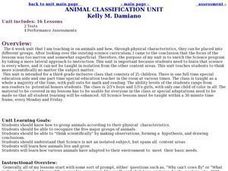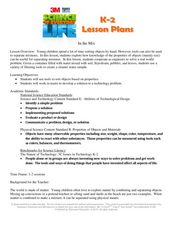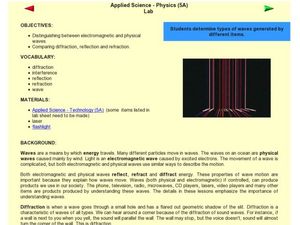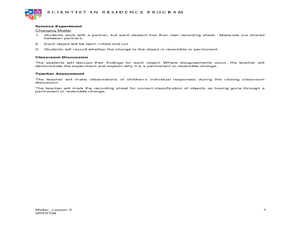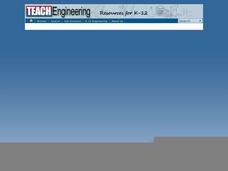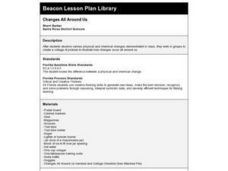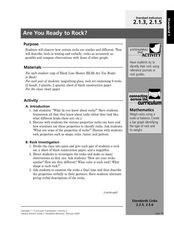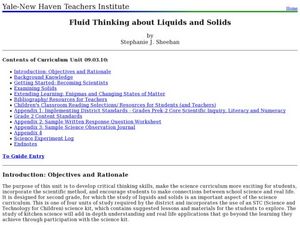Curated OER
Properties of Water with a Splash of Color
Students explore the properties of water. In this cross curriculum art and physical science lesson, students experiment with a variety of materials to demonstrate the cohesive forces and adhesion of water. Students create a water color...
Curated OER
Animal Classification Unit
Third graders study how to group animals by their physical characteristics. They examine how animals have adapted to have their needs met by the environment.
Curated OER
In the Mix
Students construct a water filter. In this engineering lesson, students discover how to construct a water filtration system. Students work in groups to sort tools by their properties. Students analyze and construct a water filtration...
Curated OER
Glurch II
Students make glurch using materials provided. In this chemistry activity, students identify the physical properties of glurch. They compare its properties to commercially prepared ones.
Curated OER
Electromagnetic and Physical Waves
High schoolers compare and contrast electromagnetic and physical waves. In this wave lesson, students discover that all waves reflect, refract, and diffract energy. High schoolers work in small groups to experiment with waves and...
Curated OER
What About Cantaloupes?
Second graders investigate the physical properties of cantaloupe using their senses. In this life science lesson, 2nd graders estimate the weight of their sample. They get it's actual weight and compare it with their estimate.
Curated OER
Physical Changes to Matter
Pupils explore matter by conducting an in-class experiment. They experiment with water's various forms by melting and freezing water, identifying its new shape. These observations are recorded to supplement later discussion. They also...
Curated OER
Water Snails
Students study water snails. In this water snails lesson, students research the habitats of water snails. After conducting research, students investigate water snails in their habitats and generate scientific observations.
Curated OER
Praire Biome Models
Fifth graders, in groups, list the physical characteristics of a biome and think of ways in which animals might have to adapt to live there and make a biome mobile ball that show the different types of habitats that shape the praire biome.
Curated OER
Mother-Infant Observation
Students observe a mother and infant playing for ten minutes. In this mother-infant observation lesson, students evaluate the infant's activity according to physical characteristics, locomotion, communication, and patterns of...
Curated OER
It's not just pretty - it's a survival method!
First graders write explanations for why certain animals can only live in certain environments. In this animal survival lesson plan, 1st graders take pictures of animals and place them into the right environment after a instructional...
Teach Engineering
Both Fields at Once?
An MRI uses both a magnetic and electricity, so how do the two interact with each other? Class members observe the effects on a charged particle when it is subject to both an electrical and magnetic field. The teacher background...
Curated OER
Changes All Around Us
Sixth graders, in groups, observe the difference between physical and chemical changes and create a collage of pictures to show the difference.
Curated OER
How Does Your Garden Grow?
Students construct and maintain a school garden. In this gardening lesson, students plan the construction of the garden by writing letters to local businesses asking for supplies and materials; students build the garden using their math...
Curated OER
Naked to the Eye
Sixth graders study microorganisms. In this microorganism lesson, 6th graders explore the form and function of these organisms. Students use magnification during experiments on bread.
Curated OER
Separation of a Complex Mixture
Students develop a method to separate different types of mixtures. In this chemistry activity, students model the steps in the scientific method. They perform the experiment and analyze data.
Curated OER
What Do Magnets Do?
Second graders discover the physical properties of magnets. In this physics lesson, 2nd graders investigate the differences between natural and man made magnets and the uses of each. Students complete 4 separate RAFT...
Curated OER
Build a 3-d Plant Model
Third graders construct a three-dimensional model of a flowering plant. They examine the major plant parts and their basic functions. They demonstrate an understanding of the similarities and differences in the physical...
Curated OER
Are You Ready to Rock?
Second graders investigate rock samples using magnifying class. In this earth science lesson, 2nd graders identify the physical properties and describe them verbally with their partners. They compare their findings with the class.
Curated OER
Fluid Thinking About Liquids and Solids
Second graders examine the physical characteristics of the different states of matter. In this chemistry lesson, 2nd graders observe how matter changes from one phase to another. They classify substances according to its type of matter.
Curated OER
The Case of Similar Substances
Students perform tests in the lab to identify an unknown substance. In this physical science lesson plan, students observe the physical and chemical properties of substances. They formulate a conclusion based on experimental results.
Curated OER
Principles Of Flight: Wings That Spin
Students discover how flight is possible. In this physics lesson, students investigate the properties of a blimp and gyro-copter, comparing rotating wings and fixed wings of aircraft. Students create their own model aircraft...
Curated OER
What's The Scoop?
Students explore the properties of matter. In this cross curriculum three states of matter science instructional activity, students listen to the poem "Eighteen Flavors" by Shel Silverstein, and predict what will happen if listed...
Curated OER
Thermo and Fluid Dynamics of a Homemade "Lava Lamp"
Students construct their own lava lamp using simple substances. In this physics lesson, students explain how difference in density causes convection. They solve for forces and buoyancy using mathematical equations.

